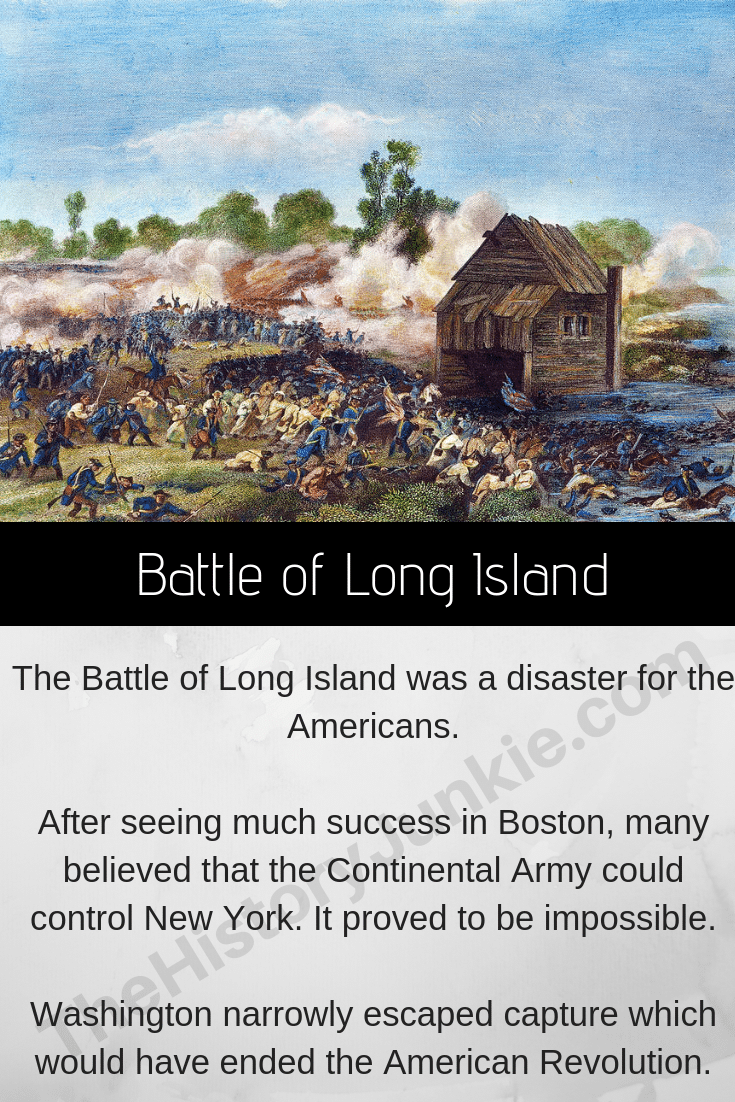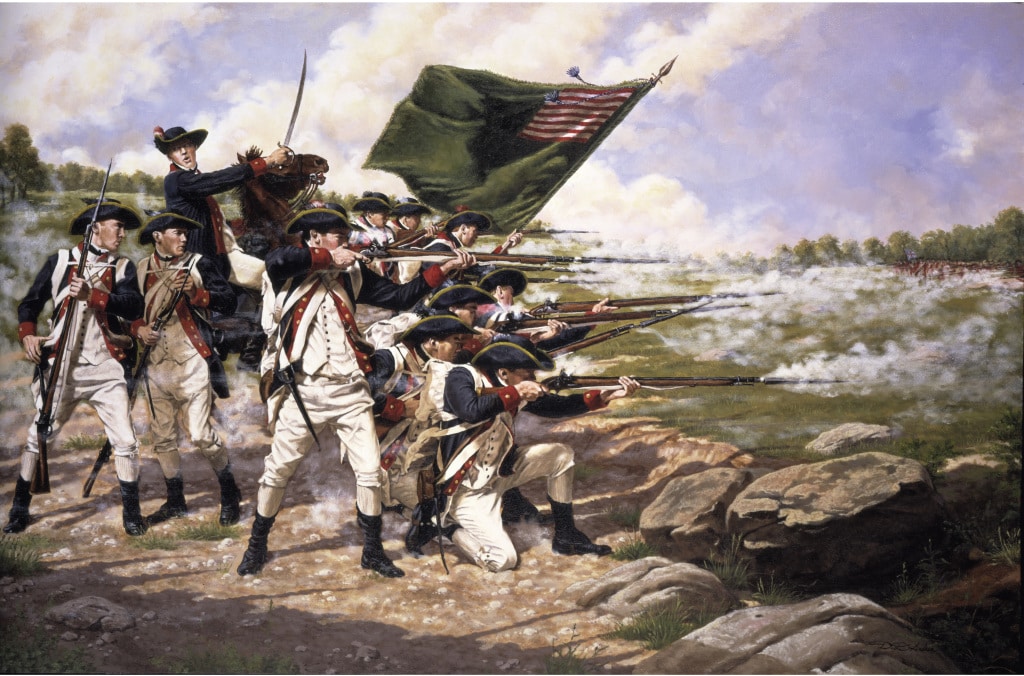The Battle of Long Island was the first display of British military power. They were out-manned, outgunned, and outmaneuvered in Boston and eventually were forced to retreat.

Although they were embarrassed in Boston, General William Howe knew that the key to the Americas was New York if the British were able to control New York, than they would be able to cut the colonies in half.
Boston, although a large city, did not offer any tactical advantage. George Washington was assigned a near-impossible job.
British Perspective: After the disaster in Boston, the British reorganize their forces and prepared to launch an attack on Long Island. General William Howe would lead the forces on the ground, and his brother, Admiral Richard Howe, would lead the British Navy.
While preparing his battle plan, General Howe would remember his experience at Bunker Hill. He remembered the American forces, how they fought, and how he underestimated them. This time, he would do it with more respect and less arrogance.
He understood that to win this war, he must not take as many casualties in battle. This time, he would also have his brother, which was the ace in the hole that the Americans could not counter.
In Boston, the British were undermanned and outgunned. That would not be the case here as they brought in a joint force of 40,000 men to put an end to this rebellion.
New York, unlike Boston, had more loyalists, and Howe had an impressive amount of intelligence. The loyalist spies informed him of weaknesses in the rebel line and tempting targets.
General Howe came into New York with more knowledge and respect for the Americans and developed a skillful assault on the Americans.
Howe made his first move on August 22 in the form of an amphibious assault. He launched 4,000 men from Staten Island and landed on the southwest side of Long Island. The rest of his army moved under the cover of the British Navy and were unchallenged.
Once across, Howe split his forces into two wings of 10,000 men. He rested and was ready for a couple more days, and then, by the morning of August 27, Howe began the Battle of Long Island.
American Perspective: American morale was at its peak just before the Battle of Long Island. The Americans had successfully defended themselves in the Battles of Lexington and Concord, and they had inflicted a great deal of loss on the British at the Battle of Bunker Hill.
These successes encouraged recruits and gave the illusion to the Americans that they could easily defeat the British. The Declaration of Independence had also been written and signed, and America had now declared its independence from Great Britain.
Young men from the colonies flocked to join the Continental Army. By the time of the Battle of Long Island, the American numbered 19,000 men.
Washington knew better than to underestimate the British Army. After all, he had served in it during the French and Indian War. He undertook the daunting task of defending Long Island without an effective Navy and militia.
Washington understood that the British would be able to take Long Island, but his aim was to inflict as many casualties as possible, making it costly for the British.
This would be much more difficult than the Boston Campaign for three reasons:
- While the terrain was similar to Boston, the land area was much larger.
- The British Navy could be much more effective in New York than in Boston.
- Nathanael Greene became ill and was taken from the field before the Battle of Long Island even began. Israel Putnam took his place and was overwhelmed with the task.
The General in charge of this vast undertaking was General Nathanael Greene. Greene focused his resources on a line that was supported by three small forts: Putnam, Greene, and Box.
This line would have to be taken if the British wished to threaten New York with a ground assault.
Two days before the Battle of Long Island, Greene became ill with fever and was removed from the battlefield and replace by John Sullivan, who was replaced by Israel Putnam.
The loss of Greene meant the loss of his knowledge of the terrain and his superior knowledge of tactics. His replacement, Israel Putnam, was simply overwhelmed with the task.
Putnam was a hero at Bunker Hill, but at the Battle of Long Island, he was a liability. He fought hard but was not able to handle such a complicated task.
Battle of Long Island Facts: The Fighting

The Battle of Long Island began on the morning of August 27 when Howe ordered General Grant to move his 5,000 soldiers north along the Gowanus Road. This move led to some small skirmishes with rebel forces.
General Putnam ordered 1,600 men under the command of General William Alexander to meet the advancing men of Grant. Grant simply stopped before the rebel line and shelled the patriots, and threatened with an infantry attack.
While Putnam's forces were engaged, General Sullivan had moved to the center of the line, where he came into contact with Von Heister's Hessian troops. Sullivan dispatched troops to reinforce Alexander, which was a costly mistake and gave Howe an even greater advantage.
Once the fighting began in the Patriot right and center, Colonel Samuel Miles moved his Pennsylvania riflemen west towards the combat. Unfortunately, this left Putnam's extreme left flank completely exposed.
He was ordered to return to his earlier site to protect the flank, but it was too late. By the time of his arrival, he only saw the tail end of Howe's column. In a desperate act, Miles sent half of his men toward the main line to warn the others, and the rest of them attacked the baggage train.
Most of the force was decimated, and 160 men were captured, including Miles himself. The situation had gone from bad to worse for the Americans. With Miles's capture, Howe's men could now set a trap.
Once Howe's men reached Bedford, they were behind Sullivan's men. Sullivan would not last long. Howe fired a signal telling Von Heister and Grant to attack. Von Heister attacked Sullivan, and within minutes, Sullivan's line crumbled.
The Americans were thrown in chaos. Men were running in all directions to try to reach the main line in Brooklyn, but most were captured or killed. General Grant engaged General Alexander, who was holding up Putnam's far-right flank. Grant overwhelmed him and broke Alexander's line.
During the retreat, Alexander ran into Cornwallis and his Highlanders. In order to break the tightening noose, Alexander launched a series of dangerous attacks, which allowed some of his men to escape.
However, Alexander was captured, and the entire right flank of the Continental Army collapsed. Howe's plan was working to perfection.
With the entire Continental Army collapsing around them, the remaining Americans fell back to Brooklyn Heights. Howe's Army moved in, and in the biggest blunder of the Revolutionary War, he halted his army.
General George Washington and his men were trapped and at his mercy, yet he did not move. The next day, rain curtailed any sort of fighting, and the two armies remained dormant. Due to the rain and the wind, Admiral Howe could not move the Navy behind Washington and the Continental Army and effectively end the Revolution.
Instead, on August 29, a heavy fog set in, and when it cleared, the entire Continental Army that was stationed on Brooklyn Heights was gone.
William Howe had lost the best chance in the entire war of capturing Washington's army, which was the lifeblood of the American Revolution.
Outcome
Howe's failure to capture Washington can overshadow the devastating effects this loss had on the Americans. Just a few weeks before the Battle of Long Island, the Thirteen Colonies had declared their independence from Great Britain.
They had successfully driven the British out of Boston and had inflicted heavy casualties on them at Bunker Hill. However, this time, they were defeated soundly, and it was only the beginning.
After the battle, many Americans did not have confidence in the final outcome and many started to lose faith in General Washington. The British had gained control of the most important tactical city in the middle colonies.
New York gave the British control of the St. Lawrence River.
Battle of Long Island Facts: Online Resources
- Wikipedia - Battle of Long Island
- Governor's Island - Long Island National Park
- American Military History Podcast - Battle of Long Island Transcript
- New York Historical Society - Battle of Brooklyn
- Library of Congress Collection of Revolutionary War Maps
- Guide to the Battles of the American Revolution
- Journal of the American Revolution
- The History Junkie’s Guide to the American Revolutionary War
- The History Junkie’s Guide to American Revolutionary War Battles
- The History Junkie’s Guide to the American Revolutionary War Timeline
- The History Junkie’s Guide to the 13 Original Colonies
